Jumping to Conclusions
Forty years after its creation, the jump cue is still a controversial topic, although its impact on the game can’t be disputed.
By Keith Paradise
Playing in the semifinals of March’s Predator World 10-Ball Championship in Las Vegas, former world champion Fedor Gorst found himself in a difficult situation.
With the 9 ball blocking his path to the 5 ball near the corner pocket, he grabbed his jump cue and swiftly popped the object ball into the corner pocket. After landing the ball, the cue ball rolled behind the 8 and the Russian, with the jump cue still in hand, quickly jumped over the obstruction and rolled the 6 ball into the side pocket with a slight cut shot. Again, the cue ball refused to cooperate, now drifting behind a 10 ball that now blocked his path to the 7. Gorst once again used the black carbon fiber cue to pocket the 7 on a bank shot but this time scratched in the far corner pocket, as the crowd at the Rio All-Suites Hotel and Casino groaned at the misfortune before ultimately cheering the performance they had just witnessed.
Sanchez Ruiz held on for the win, but Gorst walked away with one of the most talked about moments in the tournament.
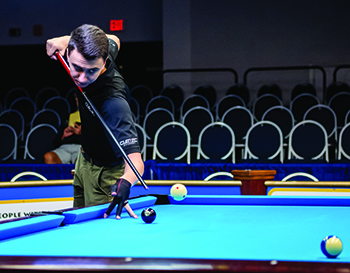
Forty-years ago—even 20 years ago—if you wanted to watch professional pool players sending cue balls airborne to pocket balls like this there was a better than good chance you were probably tuning into “Trick Shot Magic” on ESPN, a series of televised trick shot competitions promoted and aired on the network. But as cue manufacturers have continued to introduce jump cues into the professional game, players have developed a proficiency with the tool to the point that being able to jump accurately has become as critical a skill to learn as breaking and position play.
Over four decades after its almost accidental creation, the jump cue has slowly grown to become the third cue that virtually every professional player carries in their case.
“I think the top players are starting to get it,” said Gorst in a phone interview from the Philippines. “Five years ago, it was more about who was breaking better. But now, since they’re changing the break and rack formats, it leads to a lot of safety battles where you have to jump.”
“The jump is becoming more and more a really big part of the game,” said Billiard Congress of America Hall of Famer Ralf Souquet. “Because of the new equipment over the last five to 10 years, if you’re a certain height and if your fingers are long enough, you can jump quite easy. I’m not saying you’re going to make the ball but you’re going to clear the object.”
As is usually the case with new technology in any game—such as the hybrid club in golf—acceptance and proficiency at the pro level has now trickled down to the amateur ranks as well. Not surprisingly, the increase in demand had led to more manufacturers making and selling the sticks. According to Kyle Nolan, product development lead at Cuetec, the brand’s jump cue sales have grown by more than 50 percent year after year for the past four years. Online retailer Pooldawg currently has 24 jump cues for sale from approximately 10 different manufacturers, with many of the higher priced carbon fiber models made by Predator and Cuetec currently out of stock.
“I was pretty surprised by it too, but we have a really hard time keeping the carbon fiber jump cues in stock,” said Keven Engelke, General Manager for the popular online retailer. “When we have them, they definitely are moving.”
Even some professional players are getting into the action, with brothers and former world champions Ping Chung and Pin Yi Ko developing their own line of jump cues which were introduced onto the market in the last couple of years.
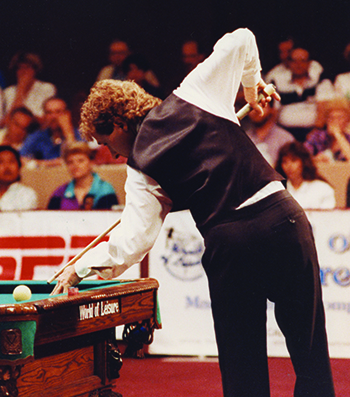
Jump cue technology has come a long way since the “short sticks“ used by Nick Varner in the early ’90s.
“Because we practice our jumping every day, we can jump a little bit better than the average player,” said Ping Chung, former World 10-Ball Champion, in a text message. “It was because of this reason that we wanted to do our own jump cue.”
While the cue started as a tinkerer’s invention and evolved into a staple in the artistic pool industry before ultimately becoming entrenched in the pocket billiards game of the 21st century, the jump cue is not without controversy. Of all the modern inventions that have been created over the last half century designed to make the game easier—carbon fiber shafts, low-deflection shafts, break cues and composite tips—the jump cue might be the one that has created the most debate, with some promoters and leagues still prohibiting them four decades after their invention.
Regardless of the variance of opinions, the game is more three-dimensional than it has been in the last 100 years, and with the recent improvements that have come on line in recent years, shots like what Gorst pulled off in Las Vegas might only be the beginning of what’s to come.
Pat Fleming was messing around with a masse cue on his home table around 1981, attempting to curve the cue ball around a blocking ball towards his target.
While attempting to shoot around the nuisance sphere, he watched as the cue ball jumped over the ball instead. He stood there for a moment puzzled. Why did it go over when he wanted it to go around? More importantly, he wondered if he could make it happen again. And so, he tried it and it did. And then again. And again.
“All of the sudden, I realized that I could jump balls with this cue,” said Fleming.
He took it to Long Island cuemaker Pete Tascarella, who was just starting his cue-making operation after acquiring the late George Balabushka’s equipment, and asked him to build an extension for this cue out of lightweight balsa wood. Fleming then headed to Florida where he used his invention in a tournament.
“I was jumping balls like crazy and, of course, no one had seen this before,” said Fleming. “Then I started using it everywhere that I went.”
Conversely, Tascarella saw what Fleming was able to do with the shortened cue and developed a breaking cue that would disengage about halfway between the joint and the butt end, one of the earliest models of a jump-break cue. He made and sold a handful and a friend suggested he patent the design, but he sold such a limited volume of cues he didn’t think it was worth the energy.
Meanwhile a time zone away, Sammy Jones had perfected getting a ball airborne simply with the shaft of his two-piece cue, becoming proficient at gambling games which involved him playing with or executing jump shots with the top half of his cue. Gambling and hustling in the South in the early 1970s, Jones had mastered the art of coming up with gimmick games to win money. He eventually perfected a trick shot over time where he could jump an entire rack of balls with the shaft.
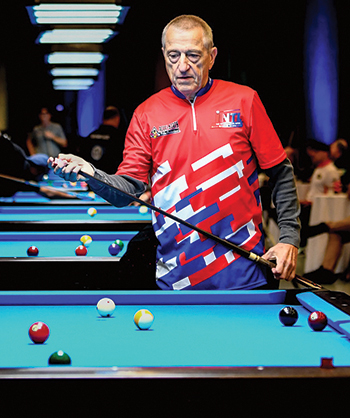
Fleming was simply testing a masse cue when he realized how easy it made jumping balls.
“It was kind of a neat feeling to be able to do that,” said Jones. “Not everyone could do it because no one really knew what it was all about.”
When Fleming learned of this skill, he assumed that Jones had developed some sort of trick shaft that could vault a ball over a blocker. When he was in Kentucky a few months later for a tournament and ran into Jones, he asked him about this rumor that he had heard. After Jones confirmed the rumor, Fleming waited for him to pull out some contraption from hie case. Instead, Jones asked to borrow Fleming’s shaft and casually jumped the cue ball over an object ball.
By now, he had picked up the nickname “Jumpin’ Sammy Jones,” eventually having a handle made for the shaft that he would use in competition. He slowly noticed that the crowd clapped for certain things during a match, such as a pocketed 9 ball on the break and when he made a jump shot with his new contraption.
“So, this was pretty cool,” said Jones. “And then everyone started getting a jump cue.”
Well, not everyone.
At this time, only Jones, Fleming and fellow player Dave Bollman, an employee at Q-Masters in Norfolk, Va., who also built cues, were the only competitors carrying a dedicated cue for jumping. As is usually the case when someone comes out with something unconventional, there was some backlash, most notably from Earl Strickland, who had developed his own technique for jumping balls with his playing cue. In fact, one of the most memorable shots of Strickland’s young career occurred when he executed a jump shot against Steve Mizerak in the final of the 1983 Caesars Tahoe Classic which was broadcast on ESPN.
Fleming recalled arriving at one of the U.S. Open 9-Ball Championship tournaments at Q-Masters and being approached by Jimmy Reid and a handful of fellow players. They had decided that Fleming could use his cue, as long as everyone else could as well. By the late 1980s and into the early 1990s, a handful of jump cues were hitting the market, although many of them were cues in name alone. Some were simply a wooden dowel with a hardened tip on the end, some were short aluminum rods and a couple resembled miniature baseball bats. Since there were no specifications outlined by the Billiard Congress of America or the fledgling World Pool-Billiards Association, there was not a true limit on what could and couldn’t be qualified as a jump cue. After visiting the 1994 BCA Trade Expo, Billiard Digest writer Mike Shamos reported the following:
“Among the most popular products at the BCA Trade Expo were jump cues. They came in all shapes and sizes, from a short six-ounce model that felt like balsa wood to an imposing black aluminum monster with 19-millimeter tip that resembled a cattle prod.”

Before jump cues were common, “Jumpin’s Sammy” Jones gambled using just the shaft.
In the same article, Shamos reported that the Professional Billiards Tour, then the preeminent men’s series, had recently outlawed the cue, while the Women’s Professional Billiards Association had never allowed them in the first place.
“In my opinion, that was very short-sighted,” said Jones. “First and foremost, it’s a great shot and especially to be able to sell another product in the industry. I’ve always been an entrepreneur at heart. It just didn’t make any sense that great players didn’t want to learn that shot.”
And the sticks were popular, especially with the public at trade shows. While developing his trick shot demonstration in the mid-1980s, Tom “Dr. Cue” Rossman would use one of the early jumpers developed by Gene Albright called the Kangaroo Cue, which was about 16 inches long and about 20 millimeters at the tip—a tip he told the crowd was “nitrogen gas-injected” to jump balls. He collaborated with a Minnesota inventor named Brad Boltz on his own line of cues, naming the product the Happy Hopper and inscribing a small rabbit on the butt end of it. He started ending his shows with a trick shot where he lined up a row of balls and jumped them over another line of balls into the side pocket, then told the crowd that they too could have a Happy Hopper for $225.
“Tom’s wife pulls out like a gym bag underneath and they sell like 30 of them in five minutes,” said John Barton, founder of JB Cases, who caught Rossman’s act at a BCA event. “And I mean, people can’t pull their money out fast enough.”
“It was an amazing income that we had off of these cues and, all of the sudden, everyone in the industry was coming to the booth and we sold out of them,” said Rossman.
Barton had his own jump cues for sale at his booth and began playing around with it after seeing Rossman’s act. He developed a new flared-handle cue with German cue makers Hans Joerg Bertram and Oliver Stops and a jump routine of his own. Soon, Barton’s Bunjee line was available for sale at the same shows, with Barton executing a similar series of shots during a demonstration.
The jump cue that might be the most notable of the era was The Frog, a product that was designed by a southern California mechanic and inventor and given to Robin Dodson to try out while she was practicing one afternoon at her home pool room. A two-time World 9-Ball Champion, Dodson didn’t even know how to jump a ball until she was taught how to properly use the stick.
“As soon as I jumped a ball I was like, ‘Oh my goodness, this is a game-changer,” she remembered.
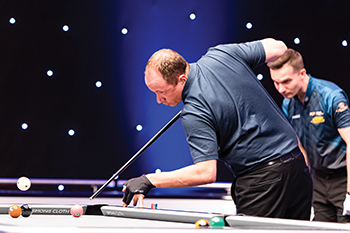
Today’s players, like Shane Van Boening, jump with pocketing and position accuracy.
When she was able to secure a manufacturer who could mass produce the cue, she was given the rights to the product and began selling it at her booth and advertising it in publications. A naturally charismatic saleswoman, Dodson was soon earning more at her pro shop booth at tournaments than she was in the competition, sometimes taking home $30,000 in a weekend. Over time, she found herself wanting her matches to be completed sooner so she could get back to the booth.
“We would bring 500 jump cues and come home with maybe 100,” said Dodson. “I mean, it’s crazy but I just sold it.”
In 1994, members of the Billiard Congress of America’s board of directors met in Arlington Heights, Ill., site of that year’s World 9-Ball Championship and debated rules and specifications for the cue and chose Dodson’s Frog as the template for standard length: It must be at least 40 inches. A standard that stands to this day in the rulebooks.
“It had the most prominence as a jump cue at that time because Robin did a little more advertising and it was probably the best-known jump cue,” said John Lewis, a BCA employee at the time. “We didn’t want to disallow it and so from then on, 40 inches is what they went by.”
Although cuemakers and inventors were coming to market with jump products, not all of them could do the job, whether it was due to having too narrow of a shaft diameter, weight distribution or tip softness. Some were simply shafts with short handles. When Dodson gave demonstrations at her booth to try and teach customers how to jump, she would have the customers dig out their own jump cue to try first to see if it worked. If theirs worked as well or better than hers, she told them. What she found was that some of them couldn’t lift a cue ball at all.
“The function of the cue has a lot to do with tip hardness and leather tips just frankly aren’t hard enough,” said Brandon Jacoby, who has been involved with his father’s Jacoby Custom Cue company for 30 years. “There were a lot of cues on the market that didn’t function really well because they just didn’t have a hard enough tip.”
When the extremely hard phenolic tip was created and installed about 25 years ago, suddenly almost anything had a jumping capability.
“Everything about that tip changed the jump shot, in my opinion,” said Dodson, who eventually transitioned to teaching the jump shot before retiring from competition in 2002. “The fall of the Frog was the phenolic tip because once everyone had that, then their jump cues were nicer.”
“You could put a phenolic tip on a broom, and you could jump with it,” said custom cuemaker Ned Morris, who chose instead to experiment with a hardened leather tip since the chemical compound had the ability to potentially damage balls.
After creating the type of tip he preferred, Morris developed the first three-piece jump cue—a device that Mike Massey used to win a handful of artistic pool championships—then partnered with Stealth to create the Air Time 1 cue around 2000, with Morris estimating that the item sold around 15,000 units overall.
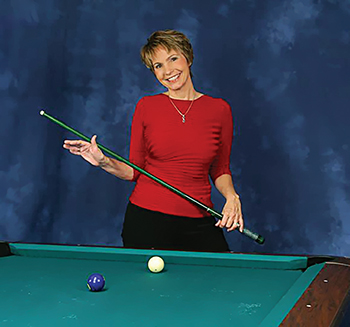
Dodson pocketed more selling her “Frog” than from winning titles.
Early in the 21st century, with the Pro Billiards Tour no longer in operation and the WPBA loosening their prohibition, production cuemakers took a bigger interest in the product, realizing it was yet another piece of equipment that could be marketed to consumers. Japanese manufacturer Miki, the company that produces the Mezz and Ignite lines, introduced its first dedicated jump cues the same year and Jacoby collaborating with local cuemaker James Peterson to build the first edition of the Jacoby Jumper in the early 2000s. Around the same time, Predator introduced the original Air series. “When we entered the market, the jump cues that were on the market could jump but they weren’t really accurate because they were heavy with phenolic on the front end,” said Philippe Singer, Vice President of Predator Group. “We put a lot of research into making a jump cue jump better and be accurate. What we found was that it couldn’t be too heavy because if its too heavy you don’t get accuracy on your jumps.” Whereas the early jump cues focused on weight more towards the front of the cue, Predator began engineering sticks that were lighter on the front end, and also experimented with cues made from different materials. According to Singer, the real game changer in terms of accuracy was the development of carbon fiber, which was introduced on the Predator’s Air Rush jump cue about five years ago. According to Singer, the material naturally has more spring than wood and the tube itself is lighter, which helps with weight distribution. “Now it’s a lot easier to pop the cue ball,” said Singer. “Carbon fiber is just a superior material for restitute force, which is the first thing that helps.”
With big name manufacturers like Cuetec and Predator now involved in the creative process, the days of inventors and garage engineers has given way to collaborative efforts between the companies and the competitors they sponsor. When Gorst first picked up a cue stick almost 15 years ago, he could barely get a cue ball into the air. While practicing on a cramped table in the family home in Moscow, he occasionally needed to switch to his Jacoby jump cue out of necessity due to a wall being in the way and slowly increased his proficiency with the shot. Now sponsored by Cuetec and established as one of the best jumpers in the game, Gorst has worked with the manufacturer on the current line of jump cues and offers feedback, as does Florian “Venom” Kohler,” the professional trick shot artist and social media sensation who is also sponsored by the manufacturer. Nolan said that the company seeks feedback from the professional players they sponsor and value their input but that their contributions need to go beyond just having talent. “If they can’t articulate the differences and can only tell you one cue is better than another, you won’t make much progress,” he said. “The key is to maintain your focus and develop a product that elevates the execution for amateur and professional players.”
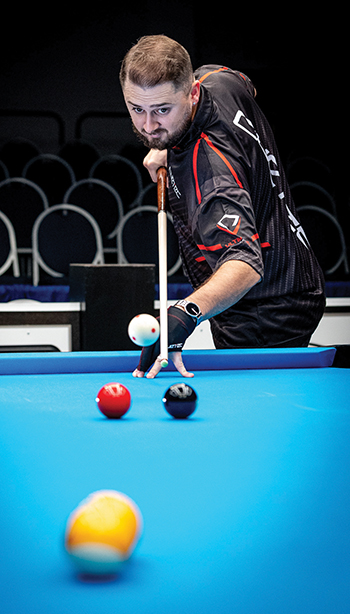
How would a star like Woodward’s game change if promoters and tours still outlawed the jump cue?
This was the objective when the company was working on the current line of Propel jump cues. Cuetec tested the product with professionals and an amateur player focus group and were experimenting with both a 13- and 13.9-millimeter shaft. The pros had little issue with the thinner shaft, but the amateurs kept adding unwanted spin because of the narrower diameter and subsequent smaller sweet spot. As a result, Cuetec proceeded with a 13.9-millimeter model, which Kohler used to set a Guinness world record for longest jump shot (9’1” over two tables).
Singer said the next evolution could be the creation of a line of jump cues that is built specifically with the advanced and recreational player in mind, since both are looking to accomplish different objectives with the shot. A professional player is not only looking to pocket a ball but also control the cue ball for position after the shot, whereas a once-a-week league player who doesn’t practice jump all that frequently is looking for a stick that will simply get the cue ball airborne easier.
“The needs of a pro are not always the same as a league player or the average buyer of the product,” said Singer. “There’s room to answer different needs with different products and segment the market.”
As carbon fiber and engineering have increased the accuracy of these cues over the last decade, the most recent improvement is again with tip technology. Composite tips made of resin and fiberglass, like Tiger’s Icebreaker and the G10, are giving players an additional element of control over their jumps, allowing them to use English and play for position after the shot without sacrificing hardness.
“Jump cues used to be focused on just being easy to jump performance and if it can be used for short jumps,” said Kaz Miki of Miki through email. “People thought that was a good jump cue 20 years ago, but now we are looking for not only easy to jump performance but cuemakers are trying to develop jump cue performance with spin control. Cue ball control is more and more important these days.”
Coincidentally, many of those custom cuemakers who helped create the niche no longer dabble in constructing jump cues. Tascarella is still crafting cues in the same style as the man whose equipment he purchased, but he contends that the man hours and materials involved in making a jump or jump-break cue simply isn’t worth the man hours that could be spent building a playing cue. Morris echoed the sentiment, devoting his time to producing playing cues for his customers.
“I’m just really proud of what I did,” said Morris. “I never knew it would go this far.”
Prideful too are some of pioneers who executed the shot at the table.
“It’s rewarding to watch something that you know you had a part of,” said Jones. “It’s rewarding to see these guys who have really taken it to a higher level. They learn how to aim it from all distances and that’s admirable, in my opinion.”
Although the cues have grown in popularity, it still isn’t an instrument that is universally accepted by league operators and tournament organizers today. The Derby City Classic, Mike Zuglan’s Joss Tour and the American Poolplayers Association prohibit the use of these sticks. Competitors like Dodson and performers like Rossman, who have not only worked with these cues but also marketed them, advocate for their permission with the caveat that the stick doesn’t make the shot; that it still comes down to technique.
“I don’t care how much technology you’ve put in a jump cue I don’t think that’s helped me make the shots,” said Rossman. “I think what has helped me make the shots is the time I’ve spent on the table practicing and learning how to use it.”
Souquet Wins in Nashville
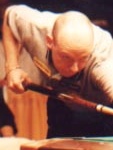 Ralf Souquet dominated Johnny Archer in the finals to win the IBC U.S. Championship, his second straight IBC event title. Souquet took the title from Archer in straight sets, 6-1, 6-1, at J. O. B. Billiards in Nashville, Tenn. Following about a week of on-site qualifiers, the event ran Sept. 13-15.
Ralf Souquet dominated Johnny Archer in the finals to win the IBC U.S. Championship, his second straight IBC event title. Souquet took the title from Archer in straight sets, 6-1, 6-1, at J. O. B. Billiards in Nashville, Tenn. Following about a week of on-site qualifiers, the event ran Sept. 13-15.
Souquet also racked up wins over Travis Stamper, 6-2, 6-3; local player Bobby Pickle, 6-4, 6-1; Japan’s Tetsu Haraquchi, 6-3,6-2; Jimmy Reid, 6-0, 6-1; and Canada’s Edwin Montal, 7-6, 6-1; before going on to crush Archer in the finals.
If $80,000 in prize money weren’t enough of an incentive, the event offered a unique chance for glory: The winner is to be immortalized in a wood carving commissioned by room owner Jim Blaylock.
